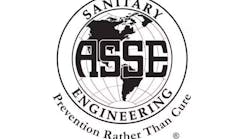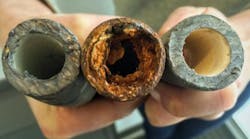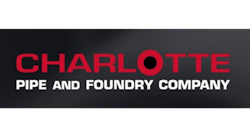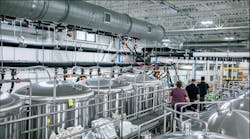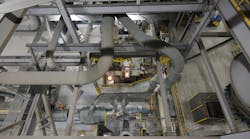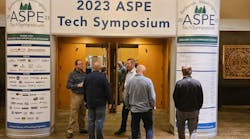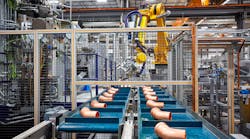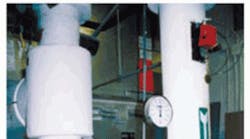The chilled-water system in a South Florida high-rise went into operation in April. By June, the pipe insulation was saturated with water, and condensation was dripping on people's heads. The problem cost more than $20 million to correct. What went wrong?
Key to the pipe-insulation failure was the all-service-jacket (ASJ) vapor-barrier facer on the 1-in.-thick phenolic-foam insulation specified for the chilled-water pipes, which were up to 16 in. in diameter and operated at 45°F. Standard vapor-barrier jackets consist of a flame-resistant white embossed paper, glass-textile fibers, and a thin aluminum foil. When wet, the aluminum foil corrodes. That is what happened in humid South Florida. When the ASJ failed, the phenolic foam filled with condensation, resembling a kitchen sponge.
The engineering firm cannot say it was not warned. The insulation manufacturer stated in its literature: "Corrosion of any metal under thermal insulation can occur for a variety of reasons. The use of corrosion-inhibiting primers and vapor-barrier coatings and/or facings will minimize corrosion potential. The potential user must perform all pertinent tests in order to determine the suitability of (trade name) phenolic insulation for the specific intended application. … It is the responsibility of the buyer."
Each of the parties involved hired an expert to review the failed insulation system. (The author was hired by the building owner.) One expert observed that the foil on the ASJ was "gone," having corroded. Another noted poor workmanship, while still another blamed "vandalism by other trades." Others stated that hangers and valves were not insulated properly. The foam-insulation manufacturer's representative said the application of the insulation system was "good and in line with standard practice," but recommended thicker insulation be installed.
The main chilled-water headers were 16 in. Some of the mechanical rooms were open to the ambient South Florida air.
With some of the lower floors rented and occupied while the contractors were completing the upper floors, the ASJ regularly was below the dew-point temperature. The result was condensation, mold, and the destruction of the thin aluminum vapor barrier.
There was considerable evidence that damage to the ASJ by other trades hastened the failure of the phenolic foam. Many of the chilled-water pipes were behind plastered ceilings or in riser chases. Many of the supply and return chilled-water pipes were installed too close together to be insulated properly.
Ceilings and walls had to be removed for the pipes to be accessed. Next, the wet, moldy insulation had to be removed. Some of the pipes, then, had to be relocated to allow adequate clearance for reinsulation.
The pipes were reinsulated with 3-in.-thick cellular glass, which has performed as designed for five years.
So, what could have prevented the failure of this chilled-water-pipe-insulation system?
- The engineer should have understood the local conditions and specified 3-in.-thick cellular-glass insulation. The specification should have included details on insulating valves, fittings, and hangers. In areas subject to abuse, polyvinyl-chloride (PVC) or 16-mil-aluminum jacketing should have been specified.
- There should have been an inspector on the job monitoring workmanship.
Conclusions
My professional-engineer license goes back 50 years. Over that time, I have worked on mechanical designs covering a wide range of building services. Insulation is a small portion of the typical mechanical engineer's scope of work. However, a lack of attention by many of my peers has resulted in the majority of my consulting practice being forensic engineering for insulation failures.
Recently, I was hired to review an engineer's mechanical-insulation specifications. The products and procedures were obsolete 40 years ago! This is not uncommon. Some consulting engineers seem to have revised their insulation specs during the 1970s, when asbestos was deleted, and not reviewed them since. Do not rely on canned specs.
The nice thing about cellular-glass insulation on cold pipes is that damage to the jacket/facer has no effect on insulation performance. That is not the case with fiberglass, phenolic-foam, styrene-foam, and urethane-foam insulation products on cold pipes.
ASJ is an excellent insulation facer, especially when combined with a self-sealing lap. It is fragile, though, and, when subjected to abuse, must be protected with an additional jacket, such as 16-mil-thick aluminum, PVC, or a heavy-duty laminate. There are several good products on the market. These jackets are a must for outdoor applications.
I consulted on a failed pipe-insulation project on which the mechanical engineer specified only ASJ on underground pipes! Failure of underground-pipe insulation is the subject of another lengthy discussion. (For more, see the author’s article "Underground Insulated Piping Guidelines" in the December 2001 issue of HPAC Engineering.)
Summary
- The coating on the phenolic-foam fittings was not a vapor barrier, while some fittings had no vapor barrier at all.
- The specified foam was too thin, which resulted in condensation on the ASJ facer, which hastened the demise of the thin foil vapor barrier in the ASJ laminate.
- The workmanship on the entire pipe-insulation system was quite poor, while damage to the ASJ caused by other trades severely compromised the vapor barrier.
- The insulation had little or no resistance to vapor in a high-humidity climate.
With more than 50 years of experience in building construction, materials technology, and design, William A. Lotz, PE, specializes in consulting on moisture and insulation problems in buildings. The author of more than 250 technical articles, he is an American Society of Heating, Refrigerating and Air-Conditioning Engineers Life Member, Fellow, and Distinguished Lecturer. He has a bachelor's degree in mechanical engineering from the University of Miami and is a registered professional engineer in eight states. He can be reached at 207-636-2625.
Did you find this article useful? Send comments and suggestions to Executive Editor Scott Arnold at [email protected].
